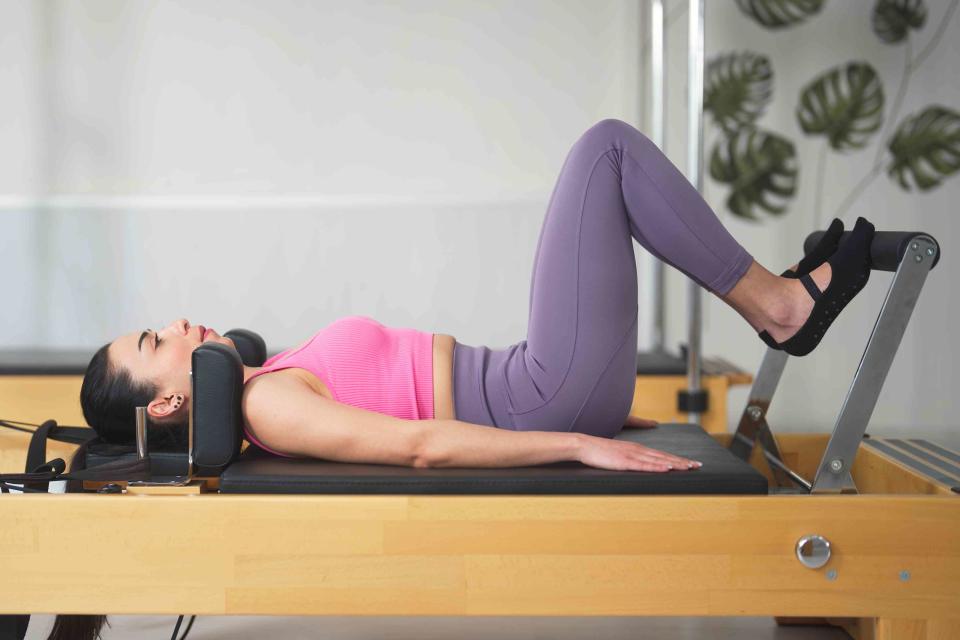What to Expect When Taking a Pilates Class for the First Time, According to Instructors
You've got this.

recep-bg/Getty Images
Trying an exercise class like Pilates for the first time naturally raises questions: What do I wear? Is this workout right for me? Will I understand what’s going on? Knowing what to expect when taking a Pilates class for the first time can help you feel more confident. (Also, kudos for trying something new!) And it’s a fantastic form of exercise that suits a variety of fitness backgrounds. “Pilates is extremely adaptable, and modifications are easy to come by to make the practice work for most people,” says Patricia Sabulis, certified yoga instructor, NASM/ACE–approved Mat Pilates instructor, and Lululemon Studio trainer.
Ready to sign up? Learn what experts want Pilates beginners to know before taking their first class.
Related: Stop Doing Crunches: 5 Simple Mat Pilates Exercises for Serious Core Strength
Know What Type of Pilates You're Signed Up For
There are a few things you want to think through before jumping into a class, says Alycea Ungaro, licensed physical therapist and certified Pilates teacher. You want to decide between trying Pilates using just a mat, which can be done virtually or in person, or Pilates using equipment, which requires going to a studio.
You may have heard of Reformer Pilates, which involves using a machine with springs that adds resistance, but there are other types of equipment too. “It’s helpful to think of Pilates as a system,” Ungaro says. Pilates can involve a variety of other equipment: a chair, spine corrector, and tower are a few items you might see in class descriptions. Generally, Reformer Pilates and mat classes can be more commonly available, depending on where you live. So how do you pick? It’s really up to personal preference and your comfort level learning to use a machine.
“Beginners may find that the Reformer makes some moves feel a bit easier because the springs help alleviate some of the weight. I find that the Reformer can be intimidating at first, so I think starting with really basic mat moves is the most accessible way in,” Sabulis says. “Mat Pilates helps the practitioner establish a baseline body awareness that they can then add resistance to on the Reformer or other apparatuses.”
Regardless of which you go with, do your research to make sure you're signing up for an introductory session first. Typically, you can choose between one-on-one training or a group class (both can be done virtually or in person), depending on how much personal instruction you want.
Related: 11 of the Best Home Workout Videos to Stream (and How to Find One You Actually Like)
You May Hear Some Unfamiliar Lingo
It can feel like you need to learn a new language when you’re in a workout class and the instructor throws out a bunch of words you’ve never heard before. In Pilates, there are a few commonly used terms that may be new to you, which will generally be covered in an intro. course, Ungaro says. (Another good reason not to jump right into an advanced class!)
Here are a few terms you'll likely hear:
The Powerhouse: This refers to the center of your body. You can think of it as a rectangle drawn from shoulder to shoulder, hip to hip, Sabulis explains.
Pilates Stance: Ungaro describes this as a slightly turned out position with your heels together and your toes apart.
The Hundred: This is an exercise done in the boat position, depending on the level of class you’re in, that engages your core and involves pumping your arms to 100 beats, says Jennifer McNeely, certified Pilates instructor who serves on the Mindbody & ClassPass Wellness Council.
Instruction Can Be Heavily Verbal
Depending on the class, Pilates instructors may not demonstrate the movements when giving instruction, says Ungaro. “You have to listen really hard and then translate words into movement,” she says. If you’re in a group class, don’t feel awkward checking out what other people are doing for guidance, she advises.
Pilates Isn’t Just About Working Out
Pilates incorporates a lot that can help you in daily life: posture, balance, breathing, body awareness, and alignment, says Ungaro. And you can walk out of your very first session noticing improvement in each of those areas, particularly alignment.
“You learn in your first session how to sit up properly,” Ungaro says. Rather than trying to get the most strenuous workout possible, focus on doing the movements with intention because Pilates is all about building a foundation that allows you to move comfortably in everything you do. “The whole point of Pilates is to get better at life—it’s to be able to climb a mountain. Pilates is about using all of the stuff you use in your class in your real life,” she says.
Related: 3 Low-Impact Types of Exercise That Relieve Stress While Building Strength
For more Real Simple news, make sure to sign up for our newsletter!
Read the original article on Real Simple.

